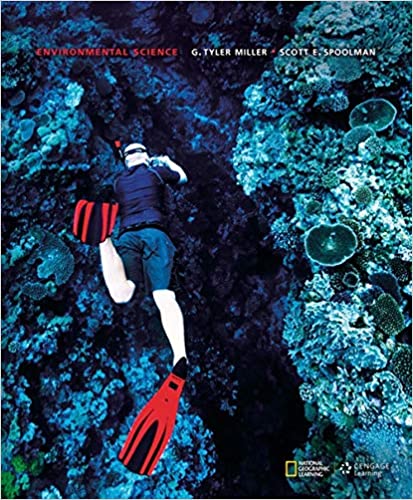
Environmental Science 15th Edition by Scott Spoolman,Tyler Miller
Edition 15ISBN: 978-1305090446
Environmental Science 15th Edition by Scott Spoolman,Tyler Miller
Edition 15ISBN: 978-1305090446 Exercise 13
STAYING ALIVE IN THE DESERT
Adaptations for survival in the desert have two themes: beat the heat and every drop of water counts.
Desert plants have evolved a number of strategies based on such adaptations. During long hot and dry spells, plants such as mesquite and creosote drop their leaves to survive in a dormant state. Succulent (fleshy) plants such as the saguaro ("sah-WAH-ro") cactus (Figure 7.11, middle photo) have no leaves that can lose water to the atmosphere through transpiration. They also store water and synthesize food in their expandable, fleshy tissue and they reduce water loss by opening their pores only at night to take up carbon dioxide (CO2 ). The spines of these and many other desert plants guard them from being eaten by herbivores seeking the precious water they hold.
Some desert plants use deep roots to tap into groundwater. Others such as prickly pear and saguaro cacti use widely spread shallow roots to collect water after brief showers and store it in their spongy tissues.
Some desert plants conserve water by having wax-coated leaves that reduce water loss. Others such as annual wildflowers and grasses store much of their biomass in seeds that remain inactive, sometimes for years, until they receive enough water to germinate. Shortly after a rain, these seeds germinate, grow, and carpet some deserts with dazzling arrays of colorful flowers that last for up to a few weeks.
Most desert animals are small. Some beat the heat by hiding in cool burrows or rocky crevices by day and coming out at night or in the early morning. Others become dormant during periods of extreme heat or drought. Some larger animals such as camels can drink massive quantities of water when it is available and store it in their fat for use as needed. Also, the camel's thick fur actually helps it to keep cool because the air spaces in the fur insulate the camel's skin against the outside heat. And camels do not sweat, which reduces their water loss through evaporation. Kangaroo rats never drink water. They get the water they need by breaking down fats in seeds that they consume.
Insects and reptiles such as rattlesnakes have thick outer coverings to minimize water loss through evaporation, and their wastes are dry feces and a dried concentrate of urine. Many spiders and insects get their water from dew or from the food they eat.
Critical Thinking
What are three steps you would take to survive in the open desert if you had to?
Adaptations for survival in the desert have two themes: beat the heat and every drop of water counts.
Desert plants have evolved a number of strategies based on such adaptations. During long hot and dry spells, plants such as mesquite and creosote drop their leaves to survive in a dormant state. Succulent (fleshy) plants such as the saguaro ("sah-WAH-ro") cactus (Figure 7.11, middle photo) have no leaves that can lose water to the atmosphere through transpiration. They also store water and synthesize food in their expandable, fleshy tissue and they reduce water loss by opening their pores only at night to take up carbon dioxide (CO2 ). The spines of these and many other desert plants guard them from being eaten by herbivores seeking the precious water they hold.
Some desert plants use deep roots to tap into groundwater. Others such as prickly pear and saguaro cacti use widely spread shallow roots to collect water after brief showers and store it in their spongy tissues.
Some desert plants conserve water by having wax-coated leaves that reduce water loss. Others such as annual wildflowers and grasses store much of their biomass in seeds that remain inactive, sometimes for years, until they receive enough water to germinate. Shortly after a rain, these seeds germinate, grow, and carpet some deserts with dazzling arrays of colorful flowers that last for up to a few weeks.
Most desert animals are small. Some beat the heat by hiding in cool burrows or rocky crevices by day and coming out at night or in the early morning. Others become dormant during periods of extreme heat or drought. Some larger animals such as camels can drink massive quantities of water when it is available and store it in their fat for use as needed. Also, the camel's thick fur actually helps it to keep cool because the air spaces in the fur insulate the camel's skin against the outside heat. And camels do not sweat, which reduces their water loss through evaporation. Kangaroo rats never drink water. They get the water they need by breaking down fats in seeds that they consume.
Insects and reptiles such as rattlesnakes have thick outer coverings to minimize water loss through evaporation, and their wastes are dry feces and a dried concentrate of urine. Many spiders and insects get their water from dew or from the food they eat.
Critical Thinking
What are three steps you would take to survive in the open desert if you had to?
Explanation
If I am in desert, then it would like ta...
Environmental Science 15th Edition by Scott Spoolman,Tyler Miller
Why don’t you like this exercise?
Other Minimum 8 character and maximum 255 character
Character 255


